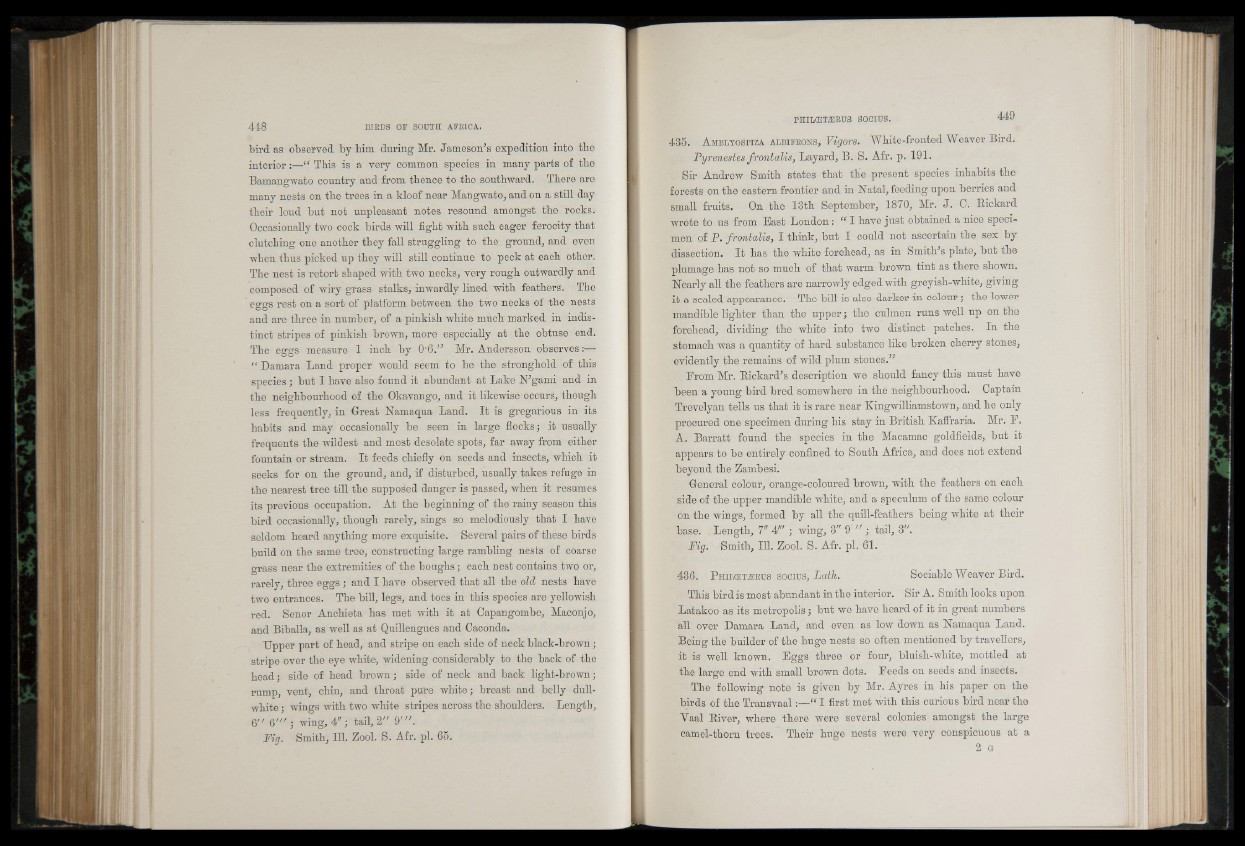
bird as observed by bim during Mr. Jameson's expedition into the
interior:—“ This is a very common species in many parts of tbe
"Bamangwato country and from thence to the southward. There are
many nests on the trees in a kloof near Mangwato, and on a still day
their loud but not unpleasant notes resound amongst the rocks.
Occasionally two cock birds will fight with such eager ferocity that
clutching one another they fall struggling to the ground, and even
when thus picked up they will still continue to peck at each other.
The nest is retort shaped with two necks, very rough outwardly and
composed of wiry grass stalks, inwardly lined with feathers. The
eggs rest on a sort of platform between the two necks of the nests
and are three in number, of a pinkish white much marked in indistinct
stripes of pinkish brown, more especially at the obtuse end.
The eggs measure 1 inch by 0'6." Mr. Andersson observes:—
“ Damara Land proper would seem to be the stronghold of this
species ; but I have also found it abundant at Lake ISP garni and in
the neighbourhood of the Okavango, and it likewise-occurs, though
less frequently, in Great Namaqua Land. It is gregarious in its
habits and may occasionally be seen in large flocks; it usually
frequents the wildest and most desolate spots, far away from either
fountain or stream. It feeds chiefly on seeds and insects, which it
seeks for on the ground, and, if disturbed, usually takes refuge in
the nearest tree till the supposed danger is passed, when it resumes
its previous occupation. At the beginning of the rainy season this
bird occasionally, though rarely, sings so melodiously that I have
seldom heard anything more exquisite. Several pairs of these birds
build on the same tree, constructing large rambling nests of coarse
grass near the extremities of the boughs; each nest contains two or,
rarely, three eggs; and I have observed that all tbe old nests have
two entrances. The bill, legs, and toes in this species are yellowish
red. Senor Anchieta has met with it at Capangombe, Maconjo,
and Biballa, as well as at Quillengues and Oaconda.
Upper part of head, and stripe on each side of neck black-brown;
stripe over the eye white, widening considerably to the back of the
head; side of head brown; side of neck and back light-brown;
rump, vent, chin, and throat pure white; breast and belly dull-
white; wings with two white stripes across the shoulders. Length,
6'7 6777 ; wing, 4'7; tail, 2'7 9'7/.
Fig. Smith, 111. Zool. S. Afr. pi. 65,
435. A m b l y o s p iz a a l b if r o n s , Vigors. White-fronted Weaver Bird.
Pyrenestes frontalis, Layard, B. S. Afr. p. 191.
Sir Andrew Smith states that the present species inhabits the
forests on the eastern frontier and in Natal, feeding upon berries and
small fruits. On the 13th September, 1870, Mr. J. 0. Rickard
wrote to us from Bast London: “ I have just obtained a nice specimen
of P. frontalis, I think, but I could not ascertain the sex by
dissection. It has the white forehead, as in Smith's plate, but the
plumage has not so much of that warm brown tint as there shown.
Nearly all the feathers are narrowly edged with greyish-white, giving
it a sealed appearance. The bill is also darker in colour; the lower
mandible lighter than the upper; the culmen runs well up on the
forehead, dividing the white into two distinct patches. In the
stomach was a quantity of hard substance like broken cherry stones,
evidently the remains of wild plum stones."
From Mr. Rickard's description we should fancy this must have
been a young bird bred somewhere in the neighbourhood. Captain
Trevelyan tells us that it is rare near Kingwilliamstown, and he only
procured one specimen during his stay in British Kaffraria. Mr. F.
A. Barratt found the species in the Macamac goldfields, but it
appears to be entirely confined to South Africa, and does not extend
beyond the Zambesi.
General colour, orange-coloured brown, with the feathers on each
side of the upper mandible white, and a speculum of the same colour
on the wings, formed by all the quill-feathers being white at their
base. Length, 777 47" ; wing, 3" 9 77 ; tail, 377.
Fig. Smith, 111. Zool. S. Afr. pi. 61.
436. P hibcetzerus socros, Lath. Sociable Weaver Bird.
This bird is most abundant in the interior. Sir A. Smith looks upon
Latakoo as its metropolis; but we have heard of it in great numbers
all over Damara Land, and even as low down as Namaqua Land.
Being the builder of the huge nests so often mentioned by travellers,
it is well known. Eggs three or four, bluish-white, mottled at
the large end with small brown dots. Feeds on seeds and insects.
The following note is given by Mr. Ayres in his paper on the
birds of the Transvaal :—“ I first met with this curious bird near the
Vaal River, where there were several colonies amongst the large
camel-thorn trees. Their huge nests were very conspicuous at a
2 G